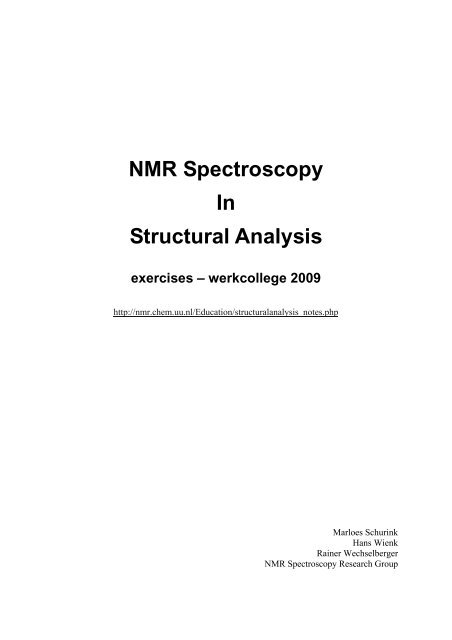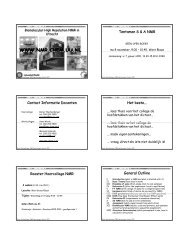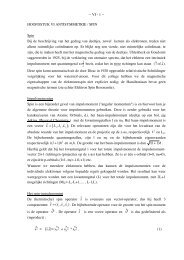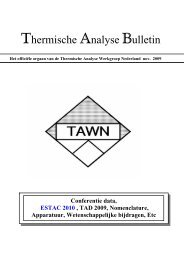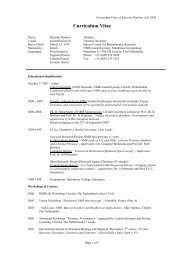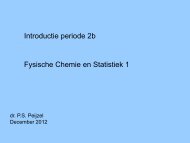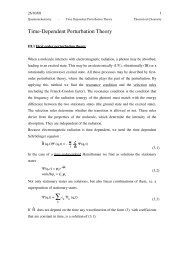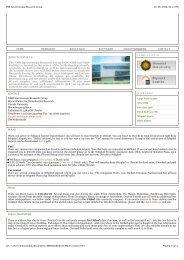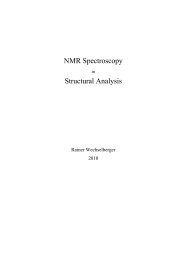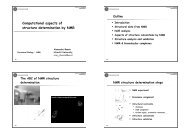NMR Spectroscopy In Structural Analysis
NMR Spectroscopy In Structural Analysis
NMR Spectroscopy In Structural Analysis
Create successful ePaper yourself
Turn your PDF publications into a flip-book with our unique Google optimized e-Paper software.
<strong>NMR</strong> <strong>Spectroscopy</strong><br />
<strong>In</strong><br />
<strong>Structural</strong> <strong>Analysis</strong><br />
exercises – werkcollege 2009<br />
http://nmr.chem.uu.nl/Education/structuralanalysis_notes.php<br />
Marloes Schurink<br />
Hans Wienk<br />
Rainer Wechselberger<br />
<strong>NMR</strong> <strong>Spectroscopy</strong> Research Group
Notes.<br />
• Exercises labeled with a “B” are supplementary. Some are a bit more difficult, others<br />
are just additional exercises. Good practice material for the exam!<br />
• Answers to questions are included at the end of this book.<br />
• Answer the question yourself, before turning to the answers!<br />
• Ask! The assistants are there to help you.<br />
Chapter 1. <strong>In</strong>troduction<br />
B1. <strong>NMR</strong> deals with nuclear magnetism, arising from the magnetic moment of the nucleus<br />
of some types of atoms. The everyday form of (macroscopic) magnetism as manifested<br />
by permanent magnets and magnetizable materials, has a different source. Find out<br />
which.<br />
Chapter 2. Basic <strong>NMR</strong> Theory<br />
2. a) Draw the energy diagrams and indicate the α and β spin states for the following<br />
nuclei:<br />
3 H γ 3 H = 2.8535 · 10 8 (T·s) −1 (I = 1/2)<br />
113 Cd γ 113 Cd = 5.9340 · 10 7 (T·s) −1 (I = 1/2)<br />
b) At what frequency do these nuclear spins resonate given a 1.5 Tesla (T) magnetic<br />
field?<br />
c) What are the corresponding angular frequencies (“hoeksnelheid”) of the precession<br />
motion?<br />
3. A proton at 11.7 T resonates at 500 MHz. To what value must the magnetic field be<br />
raised in order to obtain resonance at 600 MHz?<br />
4. Prove that the energy of a randomly oriented magnetic moment in the static B 0 field is<br />
only dependent on the z-component of the magnetic moment (see reader eq. 2.6 and<br />
2.7).<br />
5. Consider the compound chloroform (CHCl 3 ) where all carbon-atoms are of the 13 C-<br />
isotope. The difference in the Larmor frequency of the 13 C spin and 1 H spin is 675<br />
MHz. What is field strength of the B 0 field? What is the proton Larmor frequency? Use<br />
Table 1 on reader p. 9.<br />
6. The equation of motion (reader eq. 2.11 on p. 10) is crucial to describe <strong>NMR</strong><br />
phenomena. Derive reader eq. 2.12 from eq. 2.11 and verify that eq. 2.13 is a correct<br />
solution (p. 10/11).<br />
3
B7. The earth magnetic field has a strength of roughly 45 μT.<br />
a) What is the proton resonance frequency in the earth magnetic field?<br />
b) What is the wavelength of the electromagnetic radiation that can be absorbed at this<br />
field?<br />
Chapter 3. An ensemble of Nuclear Spins<br />
8. a) Consider an ensemble of 1 H nuclear spins. What is the ratio of the populations of the<br />
upper and lower states at 25 °C and a magnetic field of 2.35 T?<br />
b) What is the population difference between the two spin states per 1·10 6 spins?<br />
c) What is the population difference for 13 C, under the same conditions, per 1·10 6 spins?<br />
9. A sample of chloroform is placed in a <strong>NMR</strong> spectrometer with a field strength<br />
corresponding to a proton resonance frequency of 500 MHz.<br />
a) Sketch the net-magnetization vector of the proton spins in the laboratory frame under<br />
equilibrium conditions.<br />
We want to give a 90° x-pulse to create transverse magnetization.<br />
b) What should be the frequency of the B 1 -pulse?<br />
c) Assume that strength of the B 1 -field is 0.60 mT. What should be the duration (t p ) of<br />
the 90° pulse?<br />
d) Sketch the effect of the 90°-pulse in the rotating frame using a vector diagram. What<br />
is the rotation frequency of the rotating frame?<br />
10. Sketch in a vector diagram (rotating frame, on resonance) the effect on the<br />
magnetization of a certain proton for the following cases.<br />
a) Start with equilibrium (+M z ) magnetization. Apply a 90° x-pulse.<br />
b) Repeat the same for a 90° y-pulse .<br />
c) and a 180° y-pulse<br />
d) and a 90° −x-pulse<br />
e) and a 270° x-pulse. What is the difference compared with d)? What if the pulse is<br />
slightly miscalibrated (e.g. if it is slightly too short)?<br />
f ) Start with +M x magnetization. Apply a 90° x-pulse.<br />
g) Start with +M x . Apply a 90° y-pulse.<br />
h) Start with +M y . Apply a 90° x-pulse.<br />
i) Start with +M y . Apply a 90° y -pulse.<br />
11. You want to excite equilibrium magnetization. Unfortunately your excitation pulse is<br />
miscalibrated and is only an 80° pulse instead of a 90° pulse. How much of the<br />
equilibrium magnetization will be in the transverse plane?<br />
B12. Use the equation-of-motion (reader eq. 2.11) to calculate the effect of a 90° y-pulse. The<br />
magnetic moment μ for a single spin can be replaced by the net magnetisation vector M<br />
combining all spins of the ensemble.<br />
B13. Consider exercise 9 again. Suppose you use a B 1 -pulse with a frequency of 400 MHz.<br />
To examine the effect of this pulse, we need to use a rotating frame with a rotation<br />
frequency of 400 MHz.
a) Sketch in a vector diagram the net-magnetization vector in equilibrium in this<br />
rotating frame.<br />
b) Sketch in a vector diagram the magnetization vector of an individual spin in this<br />
rotating frame. What is the precession frequency of the spin in this rotating field?<br />
c) What is then the effective B 0 field in this rotating field? Use Hz as the unit for<br />
magnetic field strength.<br />
d) What is the total effective B-field in this rotating field, so B 0 + B 1 ? Assume a B 1<br />
strength of 25 kHz.<br />
e) Predict the result of a 10 μs B 1 -pulse.<br />
Chapter 4. Spin relaxation<br />
14. Assume M z magnetization. Apply a 90° x-pulse.<br />
a) Draw the path that the net-magnetization vector follows back to equilibrium, once in<br />
the laboratory and once in the rotating frame.<br />
b) Same as a) but now only consider T 2 -relaxation.<br />
c) Repeat this for an 180° x-pulse.<br />
B15. Verify that reader eq. 4.2 and 4.3 are valid solutions of eq. 4.1.<br />
Chapter 5. Fourier Transform <strong>NMR</strong><br />
16. What is the line width at half height (use reader eq. 5.8) of a signal with a T 2 of:<br />
a) 1.0 s?<br />
b) 10 ms?<br />
c) 10 μs?<br />
d) Associate the T 2 ’s of a), b) and c) with either a solid protein, chloroform, or a protein<br />
in solution. Explain using the graph on reader p. 20.<br />
e) Sketch the 1D spectra of compounds containing only two protons, with T 2 simliar to<br />
those of a dissolved protein, dichloromethane and a solid protein. The difference in the<br />
Larmor frequencies of the two protons is 100 Hz.<br />
17. Sketch roughly the Fourier transforms of the following FIDs (on the left the M y part of<br />
the FID, on the right the M x part).<br />
a)<br />
5
)<br />
c)<br />
d)<br />
B18. The T 1 of a certain sample decreases with increasing temperature. At 20 °C it is<br />
necessary to leave 10 seconds between successive scans, while at 40 °C only 5 seconds<br />
are required. Suppose that 3 hours of spectrometer time are available and that the<br />
instrument is set up for operation at 20 °C. It takes 1 hour to warm the sample to 40 °C<br />
and to stabilize the temperature. Assume that the <strong>NMR</strong> signals are identical at the two<br />
temperatures. What is the best strategy for recording the <strong>NMR</strong> spectrum: running for 3<br />
hours at 20 °C or warming the sample and running for 2 hours at 40 °C? Use eq. 5.9.<br />
Chapter 6. Spectrometer hardware<br />
19. a) What is meant by ‘resolution’?<br />
b) What are the possibilities to raise the signal-to-noise-ratio (S/N) for a 1 H experiment?<br />
c) Compare the S/N in an <strong>NMR</strong> experiment using 13 C nuclei at natural abundance with<br />
the S/N of 1 H.<br />
20. You want to record a spectrum of compound which has several signals in the range of<br />
-12 kHz to +5 kHz. To what value must the dwell-time be set?
B21. If the magnetic field varied by ± 10 nT between the edges of the sample, what level of<br />
error would this introduce in the resonance frequency of 1 H nuclei at a magnetic field<br />
strength of 11.7 T (500 MHz)? Compare this error to the typical line width of a 1 H<br />
signal of 1 Hz.<br />
Chapter 7. <strong>NMR</strong> parameters<br />
22. Consider a compound containing two 1 H spins that give signals at 2.0 and 7.0 ppm,<br />
respectively. You perform a 1D experiment at a 500 MHz spectrometer. Calculate the<br />
precession-frequencies in the rotating frame for the two signals, assuming a carrierfrequency<br />
(the zero-frequency of the rotating frame) which is at 4.7 ppm.<br />
23. The chemical shift of two equivalent methylene protons is 3.157 ppm. Their <strong>NMR</strong><br />
signal is split in two lines due to the scalar coupling (J-coupling) to the attached 13 C<br />
nuclear spin. The value of the scalar coupling constant is 132.15 Hz. The magnetic field<br />
strength is 0.5 T. What is the difference when the magnetic field is 10 T?<br />
a) Calculate the chemical shift difference between the two methylene signals.<br />
b) Calculate the frequency difference between each methylene signals and the reference<br />
signal of TMS at 0 ppm.<br />
c) What is the chemical shift difference when the field is ten times stronger?<br />
Chapter 8. Nuclear Overhauser effect<br />
24. The following NOEs are observed involving the aromatic protons of a tyrosine (see<br />
appendix p.110 for the atom nomenclature):<br />
atom pair η-intensity R (Å)<br />
H δ2 - H ε3 0.125 2.45<br />
H ε5 - H δ6 0.125 2.45<br />
H δ2 - H β1 0.05 ?<br />
H δ2 - H α 0.02 ?<br />
H δ2 - H? 0.01 ?<br />
H δ2 - H? 0.005 ?<br />
The distances between the δ and ε protons are known. Calculate the remaining distances<br />
and identify the two unassigned protons.<br />
B25. Estimate the molecular weight where the NOE vanishes on a 500 MHz spectrometer<br />
(see reader p. 46).<br />
Chapter 9. Relaxation measurements<br />
26. Derive reader eq. 9.1 from equation 4.2 and prove that at τ = ln(2) · T 1 no signal will be<br />
observed in a inversion-recovery experiment.<br />
7
27. Assume M z magnetization. What happens in the following sequence, where the delay is<br />
a certain fixed waiting time: 90 x — delay — 180 x — delay. Give a vectorial<br />
representation of the evolution of the magnetization for two spins of unequal frequency<br />
(relaxation can be neglected). Use the rotating frame to draw the vector diagrams.<br />
Assume that the the zero-frequency of this frame (the carrier-frequency) is the average<br />
of the frequencies of the two spins.<br />
Repeat this for the sequence: 90 x — delay — 180 y — delay. What is the difference?<br />
28. You measure the T 2 of the 15 N-spins in two 15 N-labeled proteins under the exact same<br />
conditions. The average T 2 of protein A is 120 ms, while the average T 2 of protein B is<br />
60 ms. Give an explanation for this difference.<br />
Chapter 10 Two-dimensional <strong>NMR</strong><br />
29. The structure of compound A undergoes a complete change by irradiating with light and<br />
is transformed to compound B: A → B. This reaction can be measured in the SCOTCH<br />
2D experiment (reader p. 56). The light pulse is short enough that we can assume that in<br />
the time of the pulse no precession of the spins occurs.<br />
a) A proton A with a resonance ω A has a frequency ω B after the light pulse. Sketch the<br />
2D-spectrum.<br />
b) What is the difference if the reaction is not complete? Sketch the 2D-spectrum again.<br />
30. The following Figure shows the <strong>NMR</strong> spectrum of the amino acid tryptophan (W)<br />
acquired in D 2 O.<br />
Figure 1. 1 H <strong>NMR</strong> spectrum of structure of Trp
a) Sketch the COSY spectrum without fine structure of the cross-peaks.<br />
b) Sketch the TOCSY spectrum.<br />
c) <strong>In</strong> the NOESY the β-protons have cross-peaks to just two of the ring protons. To<br />
which of them? Sketch the NOESY spectrum.<br />
31. The following Figure shows the <strong>NMR</strong> spectrum of the nucleotide adenosinemonofosfaat<br />
(AMP, see reader p. 81) acquired in H 2 O.<br />
Figure 2. 1 H <strong>NMR</strong> spectrum of AMP (http://www.bmrb.wisc.edu/metabolomics/)<br />
a) Sketch the COSY spectrum without fine structure of the cross-peaks.<br />
b) Sketch the TOCSY spectrum.<br />
c) Sketch the NOESY spectrum.<br />
B32. The three methyl-protons in ethanal are equivalent and are 2.55, 2.78 en 2.88 Å from<br />
the aldehyde proton.<br />
a) Calculate the NOE intensity for each of these distances assuming a calibration<br />
constant of 1·10 -50 .<br />
b) How many cross-peaks will be visible in the 2D NOESY spectrum?<br />
c) Calculate the intensity of one of these cross-peaks.<br />
d) Calculate the distance corresponding to this cross-peak.<br />
Chapter 11 The assignment problem<br />
33. Sketch and explain the 1 H-<strong>NMR</strong> spectrum of the following compounds (take only<br />
coupling over 1-3 bonds into account):<br />
a) 1,2-dichloorbenzene<br />
b) 1,3-dichloorbenzene<br />
c) 1,4-dichloorbenzene<br />
34. How many signals and what multiplicity do you expect in the 1 H spectrum for the<br />
following compounds (take only coupling over 1-3 bonds into account):<br />
a) methanol<br />
b) 1-bromo-2,2-dimethyl-propane<br />
c) 2-chloro-1-methoxy-propane<br />
9
35. Assign the proton spectra belonging to propanal (Fig. 3).<br />
Peak data (ppm-value, intensity):<br />
9.798 200<br />
9.793 371<br />
9.789 203<br />
2.475 265<br />
2.470 266<br />
2.451 271<br />
2.499 87<br />
2.446 275<br />
2.495 87<br />
2.426 92<br />
2.422 96<br />
1.137 503<br />
1.113 1000<br />
1.089 484<br />
Figure 3. 1 H <strong>NMR</strong> spectrum of propanal. (SDBSWeb : http://www.aist.go.jp/RIODB/SDBS/ (National <strong>In</strong>stitute<br />
of Advanced <strong>In</strong>dustrial Science and Technology, 07-09-06))<br />
36. Two proton spectra is shown together with the formulas of the corresponding<br />
compounds (Fig. 4). Determine the structure.<br />
Figure 4. 1 H <strong>NMR</strong> spectra of some organic compounds.
B37. Figure 5 shows the <strong>NMR</strong> spectrum of the amino acid proline (P) acquired in D 2 O.<br />
Figure 5. 1H <strong>NMR</strong> spectrum and structure of Pro.<br />
a) Draw the COSY spectrum without fine structure of the cross-peaks.<br />
b) Sketch the TOCSY spectrum.<br />
c) Sketch the NOESY spectrum.<br />
Chapter 12 Biomolecular <strong>NMR</strong><br />
38. The following peptide segment is part of a protein sequence: . . . YVGLTSA . . . Fig.<br />
6A shows the corresponding TOCSY spectrum of this part. Assign the segment. What is<br />
the origin of the peaks around 7 ppm?<br />
39. Assume this segment has an β-sheet conformation. Add the characteristic peaks you<br />
would expect in the NOESY spectrum in Fig. 6B. Use Fig. 12.4 in the reader.<br />
40. Now the segment is located in an α-helix. Add the expected peaks in Fig. 6C (use Fig.<br />
12.4).<br />
11
Figure 6A. 1 H, 1 H TOCSY spectrum of -YVGLTSA-
Figure 6B. 1 H, 1 H TOCSY spectrum of -YVGLTSA-<br />
13
Figure 6C. 1 H, 1 H TOCSY spectrum of -YVGLTSA-
B41. Consider again the peptide fragment YVGLTSA of exercises 38-40. Construct the<br />
NOE-pattern for a type-I turn starting at Gly in Fig. 7 (use Reader Fig. 12.4).<br />
B42. We perform an exchange experiment, replacing H 2 O with D 2 O. <strong>In</strong>dicate for Figs. 6B-C<br />
(questions 39 and 40) the peaks that are still visible in this solvent (directly after the<br />
exchange of solvent).<br />
For 6B, assume that the HN of the Tyrosine is in a H-bond with an opposite β-strand,<br />
and the β-strand is the outer strand of a β -sheet.<br />
For 6C, first assume that the segment is located in the middle of a long α-helix. What<br />
would be different if the helix starts with the tyrosine(Y) of the segment?<br />
15
Figure 7. 1 H, 1 H TOCSY spectrum of -YVGLTSA-
Answers<br />
Chapter 1. <strong>In</strong>troduction<br />
B1. The type of magnetism of permanent magnets and magnetizable materials is called<br />
ferromagnetism and is caused by a very strong interaction between the magnetic<br />
moments of the electron spin. The magnetic moment of the electron spin is roughly 650<br />
times as large as that of a proton. A nuclear version of ferromagnetism can therefore<br />
only exist at temperatures close to 0 K.<br />
Chapter 2. Basic <strong>NMR</strong> Theory<br />
2. a) The energy diagram consists of two energy levels (both are spin I = 1/2 nuclei), note<br />
that for nuclei with a positive gyromagnetic ratio the α-state (m = 1/2) has the lowest<br />
energy and the β-state the highest energy. The energy separation between the two levels<br />
is larger for the 3 H spin since it has a higher gyromagnetic ratio and Δ E=hγB<br />
.<br />
z<br />
b) The resonance frequency can be calculated using reader eq. 2.10a ν 0<br />
= γ<br />
2π B 0 . Thus,<br />
the resonance frequency of 3 H equals 2.8535·10 8 (T·s) −1 × 1.5 T / 2π = 0.68122·10 8 s −1 =<br />
0.68122·10 2 MHz = 68.1 MHz. Likewise, the resonance frequency of 113 Cd is<br />
5.9340·10 7 × 1.5 / 2π = 1.4166·10 7 s −1 = 14.2 MHz.<br />
Clinical MRI scanners typically operate at 1.5 T. The protons in your brain will then<br />
resonate at 63 MHz.<br />
c) The precession has the same frequency as the resonance frequency. The<br />
corresponding angular frequencies are obtained by multiplying by 2π giving 4.28·10 8<br />
s −1 ( 3 H) and 8.90·10 7 s −1 ( 113 Cd) (NOTE: the unit has to be s −1 and not Hz).<br />
3. Reader eq. 2.10a shows that the resonance frequency depends linearly (“recht<br />
evenredig”) on the strength of the magnetic field. Thus, the field should be raised to<br />
11.7 / 500 × 600 = 14.04 T.<br />
4. Reader eq. 2.6 denotes the dot-product (“in-produkt”) of the magnetic moment and the<br />
static magnetic field (two vectors), resulting in the scalar energy: E = r μ ⋅ B r<br />
. The<br />
orientation r of the magnetic field is normally taken to be parallel with the z-axis, thus<br />
B = ( 0,0,B 0 ). The magnetic moment will have non-zero xyz-projections. Thus:<br />
17
E =− r μ ⋅ B r<br />
⎛ 0 ⎞<br />
⎜ ⎟<br />
=−μ ( x<br />
μ y<br />
μ z )⋅<br />
0<br />
⎜ ⎟<br />
⎝ ⎠<br />
=−( μ x<br />
⋅ 0 + μ y<br />
⋅ 0 + μ z<br />
B 0 )<br />
=−μ z<br />
B 0<br />
5. Use reader eq. 2.10a: the resonance frequency (= Larmor frequency) of the 13 C spins is<br />
ν 13C<br />
= γ 13C<br />
2π B . For the 1 0<br />
H spins ν 1H<br />
= γ 1H<br />
2π B 0<br />
. The difference in the Larmor frequency is<br />
thus: ν 1H<br />
−ν 13C<br />
= γ 1H<br />
2π B 0<br />
− γ 13C<br />
2π B 0<br />
= ( γ 1H<br />
− γ 13C ) B 0<br />
2π ⇔ B ⎛<br />
0<br />
= 2π ν 1H<br />
−ν 13C<br />
⎞<br />
⎜ ⎟ . Thus, the<br />
⎝ γ 1H<br />
− γ 13C ⎠<br />
field strength is 2π × 675·10 6 Hz / (2.6752·10 8 - 6.7266·10 7 (T·s) −1 ) = 4.2411500·10 9<br />
Hz / 2.00254·10 8 (T·s) −1 = 21.18 T. The Larmor frequency of the protons is<br />
ν 1H<br />
= γ 1H<br />
2π B 0 = 2.6752·108 (T·s) −1 × 21.18 T / 2π = 901.7 MHz.<br />
6. Reader eq. 2.11 denotes the cross-product (“uit-produkt”) of the magnetic moment and<br />
the magnetic field. The cross-product equals the determinant of the matrix shown on the<br />
right-hand side of reader eq. 2.11. The determinant is calculated by expansion by<br />
minors (“ontwikkeling naar de eerste rij”):<br />
ex<br />
ey<br />
ez<br />
dμ<br />
By<br />
Bz<br />
Bx<br />
B B<br />
z<br />
x<br />
By<br />
= −γ<br />
Bx<br />
By<br />
Bz<br />
= −γ<br />
⋅{ ex<br />
− e<br />
y<br />
+ ez<br />
}<br />
dt<br />
μ<br />
y<br />
μ<br />
z μ μ<br />
x<br />
μ<br />
z<br />
x<br />
μ<br />
y<br />
μ μ μ<br />
x<br />
y<br />
z<br />
= −γ<br />
⋅<br />
= −γ<br />
⋅<br />
B 0<br />
{ e ( B μ − B μ ) − e ( B μ − B μ ) + e ( B μ − B μ ) }<br />
x<br />
{ − e B μ e B μ }<br />
x<br />
y<br />
z<br />
0 y<br />
+<br />
Note that e x is the unit vector (1,0,0). Similarly, e y =(0,1,0) and e z =(0,0,1). That means<br />
that the e x term shows the change of dμ/dt in the x-direction, etc.<br />
<strong>In</strong> the last line, it was used that B r<br />
= ( 0,0,B 0 ). Thus,<br />
dμ x<br />
= γB 0<br />
μ y<br />
dt<br />
dμ<br />
=− γ ( − ex<br />
B0μ<br />
y<br />
+ ey<br />
B0μ<br />
x<br />
)<br />
dμ<br />
dt<br />
or<br />
y<br />
=−γB 0<br />
μ x<br />
dt<br />
= exγB0μ<br />
y<br />
− e<br />
yγB0μ<br />
x<br />
dμ z<br />
= 0<br />
dt<br />
Note that the orientation of the resulting vector is given by the right-hand rule (see<br />
Figure on reader p. 10).<br />
Now to verify that reader eq. 2.13 is a correct solution, we back substitute the solution<br />
in the differential equation and differentiate:<br />
z<br />
y<br />
y<br />
0<br />
x<br />
y<br />
x<br />
z<br />
z<br />
x<br />
z<br />
x<br />
y<br />
y<br />
x
dμ x<br />
dt<br />
dμ y<br />
dt<br />
( μ x<br />
(0)cos(γB z<br />
t)+ μ y<br />
(0)sin(γB z<br />
t) )<br />
= d dt<br />
=−μ x<br />
(0)γB z<br />
sin(γB z<br />
t)+ μ y<br />
(0)γB z<br />
cos(γB z<br />
t)<br />
= γB z ( −μ x<br />
(0)sin(γB z<br />
t)+ μ y<br />
(0)cos(γB z<br />
t) )= γB z<br />
μ y<br />
( −μ x<br />
(0)sin(γB z<br />
t)+ μ y<br />
(0)cos(γB z<br />
t) )<br />
= d dt<br />
=−μ x<br />
(0)γB z<br />
cos(γB z<br />
t)− μ y<br />
(0)γB z<br />
sin(γB z<br />
t)<br />
=−γB z ( μ x<br />
(0)cos(γB z<br />
t)+ μ y<br />
(0)sin(γB z<br />
t) )=−γB z<br />
μ x<br />
dμ z<br />
dt<br />
= d dt μ z(0) = 0<br />
Here you have to use the chain-rule (“ketting-regel”): d/dt (f(g(t)) = d/dg f × d/dt g.<br />
Note that you have to assume that the answer is correct to establish the correctness of<br />
the answer!<br />
B7. The resonance frequency can be calculated using reader eq. 2.10a ν 0<br />
= γ<br />
2π B z<br />
. Thus, the<br />
resonance frequency of 1 H equals 2.6752·10 8 (T·s) −1 × 45·10 -6 T / 2π = 1916.0 s −1 = 1.92<br />
kHz. The corresponding wavelength can be calculated using λ = c ν (c =<br />
2,99792458·10 8 m/s), resulting in a wavelength of 156 470 m = 1.56·10 2 km.<br />
Chapter 3. An ensemble of Nuclear Spins<br />
8. a) Using the Boltzmann equation (reader eq. 3.1), and reader eq. 2.9 and 2.10 to relate<br />
the magnetic field strength to an energy difference and k = 1.38066·10 23 J/K, one finds:<br />
n β<br />
n α<br />
= e − ΔE<br />
kT<br />
= e −γhB z<br />
kT<br />
= e − γhB z<br />
2πkT<br />
= e − 2.6752⋅108 T −1 s −1 ⋅6.62607⋅10 −34 Js⋅2.35 T<br />
2π ⋅1.38066⋅10 −23 JK −1 ⋅298 K<br />
= e − 2.6752⋅108 ⋅6.62607⋅10 −34 ⋅2.35<br />
2π ⋅1.38066⋅10 −23 ⋅298<br />
b)<br />
= e − 41.6562⋅10−26<br />
2585.1⋅10 −23 = e − 41.6562⋅10−26<br />
2585.1⋅10 −23 = e − 41.6562⋅10−3<br />
2585.1<br />
= e −0.016113⋅10−3 = 0.99998389<br />
n β<br />
= (1 − n α<br />
)<br />
n α<br />
n α<br />
1<br />
⇔ 0.99998389n α<br />
=1− n α<br />
⇔ n α<br />
=<br />
1.99998389 = 0.500004<br />
Thus, for an ensemble of 1·10 6 spins there are 1·10 6 × 0.500004 = 500004 spins in the<br />
α-state and 1000000 – 500004 = 499996 spins in the β-state. The population difference<br />
for a real sample, expressed as a fraction of 10 6 spins, is thus 8.06 spins.<br />
c) For 13 C spins, this is 2.02 spins.<br />
19
9. a) The net-magnetization vector is aligned with static B 0 -field under equilibrium<br />
conditions:<br />
b) The frequency of the B 1 -pulse should match the energy-difference between the two<br />
energy-levels, which means that it should be identical to the Larmor-frequency (see<br />
reader eq. 2.9 and 2.10). Thus, the frequency should be 500 MHz.<br />
γ<br />
c) The magnetization vector precesses around the B 1 -field with ν<br />
1= 1<br />
2π<br />
B (see reader<br />
eq. 3.2). The rotation frequency is: 2.6752·10 8 (T·s) −1 × 0.60·10 -3 T / 2π = 25546 Hz. A<br />
90°-pulse corresponds to a quarter of a rotation. Thus, the length should be ¼ × 1/25546<br />
= 9.79 μs.<br />
d) To describe the effect of the 90°-pulse, the rotating frame must have the same<br />
frequency as the B 1 -pulse, 500 MHz.<br />
10. a) + M y<br />
b) –M x<br />
c) –M z<br />
d) –M y
e) –M y<br />
The magnetization vector now travels in the opposite direction to end up at the same<br />
point. If the pulse is slightly too short, a 90° –x-pulse will rotate the magnetization<br />
vector to some point above the xy-plane, whereas a 270° x-pulse will rotate the vector to<br />
some point under the xy-plane. Note that because of the three times longer pulse, this<br />
‘mismatch’ will be thrice as large, i.e. the effects of miscalibration are more pronounced<br />
for longer pulses.<br />
f) +M x<br />
g) +M z<br />
h) –M z<br />
i) +M y .<br />
Note that all rotations are clock-wise.<br />
11. The projection of the magnetization vector onto the y’-axis is given by sin(α), where α<br />
is the flip-angle. Thus, 98.5 % is in the transverse plane.<br />
21
B12. Again we use the equation of motion, reader eq. 2.11. <strong>In</strong> the rotating frame B = (0,B 1 ,0):<br />
e<br />
B<br />
M<br />
x<br />
x<br />
x<br />
e<br />
B<br />
M<br />
y<br />
y<br />
y<br />
ez<br />
Bz<br />
M<br />
z<br />
= e<br />
x<br />
B<br />
M<br />
y<br />
y<br />
B<br />
M<br />
z<br />
z<br />
− e<br />
y<br />
B<br />
M<br />
x<br />
x<br />
B<br />
M<br />
z<br />
z<br />
+ e<br />
z<br />
B<br />
M<br />
x<br />
x<br />
B<br />
M<br />
y<br />
y<br />
= e<br />
x<br />
= e<br />
= e<br />
x<br />
x<br />
B<br />
M<br />
1<br />
0 0 0 0<br />
− e<br />
y<br />
+ ez<br />
y<br />
M<br />
z M<br />
M<br />
x<br />
M<br />
z<br />
x<br />
B M<br />
1<br />
B M<br />
1<br />
z<br />
z<br />
+ e<br />
− e<br />
z<br />
z<br />
⋅ −<br />
B M<br />
1<br />
B M<br />
1<br />
x<br />
x<br />
B<br />
M<br />
1<br />
y<br />
Thus,<br />
dM<br />
dt<br />
=− γ<br />
( e B M − e B M )<br />
x<br />
1<br />
z<br />
z<br />
1<br />
x<br />
, or:<br />
dM<br />
dt<br />
dM<br />
x<br />
y<br />
=− γB M<br />
dt<br />
=− exγB1M<br />
z<br />
+ ezγBzM<br />
x<br />
dM<br />
z<br />
= γB1M<br />
x<br />
dt<br />
The solution of the differential equation is analogous to reader eq. 2.13 (just swap the<br />
x,y,z indices):<br />
= 0<br />
1<br />
z<br />
M<br />
M<br />
M<br />
z<br />
x<br />
y<br />
( t)<br />
( t)<br />
( t)<br />
= M<br />
=− M<br />
= M<br />
z<br />
y<br />
(0)cos( γB t)<br />
+ M<br />
z<br />
(0)sin( γB t)<br />
+ M<br />
(0) = 0<br />
1<br />
1<br />
x<br />
(0)sin( γB t)<br />
x<br />
1<br />
(0)cos( γB t)<br />
1<br />
Which simplifies to:<br />
M<br />
M<br />
M<br />
z<br />
x<br />
y<br />
( t)<br />
= M<br />
( t)<br />
=− M<br />
( t)<br />
= 0<br />
0<br />
cos( γB t)<br />
0<br />
1<br />
sin( γB t)<br />
1<br />
when starting from equilibrium<br />
magnetization. Thus we see a simple rotation around the y-axis going from +z to –x.<br />
B13. a). The net-magnetization is aligned with the B 0 -field, same as in 9a).<br />
b) The magnetic moment of an individual spin will make an angle with z-axis and<br />
precesses around the B 0 -field with 500 MHz in the laboratory frame. When<br />
transforming into the rotating frame, the new precession frequency is Ω = ω - ω rt , where<br />
ω is the lab-frame Larmor frequency and ω rt the rotation frequency of the rotating<br />
frame. The spin thus precesses with 500 - 400 = 100 MHz.
c) As the spin still precesses in this rotating field, it must still feel a B 0 -field. This field<br />
is now much smaller as the precession frequency is also smaller. When we express the<br />
strength of the B 0 -field in MHz, the strength is 500 MHz in the lab-frame and 100 MHz<br />
in the rotating frame.<br />
d) The total effective field is the vector-sum of the reduced B 0 and B 1 . So the strength<br />
is: B eff<br />
= B 2 0,reduced<br />
+ B 2 1<br />
= ( 100 ⋅10 6<br />
) 2 + ( 25 ⋅10 3<br />
) 2 ≈100 MHz. The angle of this<br />
effective field with the z-axis is:<br />
⎛ B ⎞<br />
α = arctan 1<br />
⎛ ⎞<br />
⎜ ⎟ = arctan⎜<br />
25⋅103 ⎟ = arctan( 0.25⋅10 −3<br />
)≈ 0.<br />
⎝ B 0,reduced ⎠ ⎝ 100⋅10 6<br />
⎠<br />
e) Since the frequency of the B 1 -pulse (400 MHz) is much lower than the resonance<br />
frequency of the spins (500 MHz), the spins are not affected by the pulse. So the<br />
orientation of the net-magnetisation vector will not change.<br />
Chapter 4. Spin relaxation<br />
14. a) <strong>In</strong> the laboratory frame: the magnetization vector starts some where in the xy-plane<br />
and precesses around the z-axis. Due to T 2 -relaxation, the component in the xy-plane<br />
will shrink. Simultaneously, the vector starts moving back to the positive z-axis due to<br />
T 1 -relaxation. <strong>In</strong> the rotating frame: now there is no precession around z-axis since the<br />
spin is on resonance. So after the pulse, the vector is along the +y-axis and the vector<br />
rotates around the x-axis back towards the z-axis. Check for yourself that the Figure is<br />
only correct if T 1 = T 2 . What does it look like if T 2 < T 1 ?<br />
b) <strong>In</strong> the laboratory frame: the magnetization vector starts some where in the xy-plane<br />
and precesses around the z-axis. Simultaneously, the length of the vector becomes<br />
smaller due to T 2 -relaxtion. <strong>In</strong> the rotating frame, the magnetization starts at the +y-axis<br />
and simply shrinks to eventually vanish.<br />
23
c) After a 180 x pulse the magnetization is along –z. As there is no x- or y-component,<br />
there is no T 2 -relaxation, only T 1 relaxation. The magnetization vector starts at –M z ,<br />
will shrink, at some point be zero, and then start growing again to become +M z . The<br />
description in the lab and rotating frame are the same since there will be no precession<br />
since there is no transverse magnetization, only longitudinal magnetization.<br />
B15.<br />
dM<br />
dt<br />
z<br />
=<br />
=<br />
d<br />
dt<br />
d<br />
dt<br />
= 0 + M<br />
1<br />
= −<br />
T<br />
⎛<br />
⎜ M<br />
⎜<br />
⎝<br />
M<br />
1<br />
eq<br />
z<br />
eq<br />
+<br />
d<br />
dt<br />
[ M (0) − M ]<br />
−1<br />
(0) e<br />
T<br />
[ M (0) − M ]<br />
z<br />
+<br />
1<br />
M<br />
z<br />
z<br />
(0) e<br />
−t<br />
T<br />
1<br />
eq<br />
and<br />
e<br />
−t<br />
T<br />
1<br />
1<br />
− M<br />
−t<br />
T<br />
eq<br />
eq<br />
−<br />
e<br />
d<br />
dt<br />
−1<br />
e<br />
T<br />
1<br />
−t<br />
T<br />
1<br />
M<br />
M<br />
= −<br />
⎞<br />
⎟<br />
⎟<br />
⎠<br />
−t<br />
T<br />
z<br />
1<br />
eq<br />
e<br />
( t)<br />
− M<br />
T<br />
−t<br />
T<br />
1<br />
1<br />
eq<br />
dM<br />
dt<br />
x<br />
=<br />
d<br />
dt<br />
= M<br />
x<br />
⎛<br />
⎜ M<br />
⎜<br />
⎝<br />
1<br />
= − M<br />
T<br />
−1<br />
(0) e<br />
T<br />
2<br />
x<br />
x<br />
(0) e<br />
2<br />
−t<br />
T2<br />
(0) e<br />
−t<br />
T2<br />
−t<br />
T2<br />
⎞<br />
⎟<br />
⎟<br />
⎠<br />
M<br />
x<br />
( t)<br />
= −<br />
T<br />
2<br />
Chapter 5. Fourier Transform <strong>NMR</strong><br />
16. The line width (l.w. or Δν ½ ) is related to the T 2 via: l.w. = 1<br />
π T 2<br />
. a) 0.318 Hz; b) 31.8 Hz;<br />
c) 31.8 kHz; d) chloroform = a, dissolved protein = b, solid protein = c. The T 2 becomes<br />
shorter as the tumbling time of a molecule becomes longer (= slower tumbling).<br />
Chloroform is a very small molecule so tumbles very rapidly, resulting in very slow T 2
elaxation = large T 2 values. A solid protein does not tumble at all, resulting in very fast<br />
T 2 relaxation = small T 2 values.<br />
e)<br />
17 Realize that in the observed FID the present frequency is Ω = ω j − ω rf (reader page 23).<br />
Ω ≠ 0 ωhen ω j ≠ ω rf , so when ν j ≠ ν rf . <strong>In</strong> a), transverse magnetisation starts at +y, then<br />
turns to +x, so turns faster than the rotating frame. Therefore in the spectrum the<br />
frequency will have a positive value. Also, when in and FID intensity goes to zero, T 2<br />
relaxation occurs and line-widths are not zero (reader eq. 5.8). <strong>In</strong> the FID shown in b)<br />
the visible wavelength is longer, so the visible frequency Ω is smaller than in a). The<br />
direction of rotation is the same as for a), so frequency is positive. The signal decays<br />
with similar speed as in a), so the T 2 and line width is the same. <strong>In</strong> c) the frequency and<br />
sign of the FID are the same as in b), but the signal decays to zero faster. That means<br />
that T 2 is shorter and the signal gets broadened. <strong>In</strong> d), the magnetisation starts at +y and<br />
then turns to –x. This means that is rotates slower than the rotating frame and gives a<br />
negative frequency.<br />
a) b)<br />
-25 0 (Hz) +25 25 0 (Hz) +25<br />
ν j − ν rf<br />
c) d)<br />
ν j − ν rf<br />
-25 0 (Hz) +25 25 0 (Hz) +25<br />
ν j − ν rf<br />
ν j − ν rf<br />
25
B18. At 40 °C you can record twice as many scans within a the same time as at 20 °C. <strong>In</strong> 2<br />
hours, you thus record 2 × 2/3 = 4/3 as much scans at 40 o C as in 3 hours at 20 °C. The<br />
4<br />
signal-to-noise is thus better at 40 °C.<br />
3<br />
Chapter 6. Spectrometer hardware<br />
19. a) <strong>In</strong> the context of <strong>NMR</strong> resolution is used to refer to the resolving power of the <strong>NMR</strong><br />
spectrum, i.e. the degree to which peaks with small differences in resonance frequency<br />
can be distinguished.<br />
b) According to reader eq. 6.1 one can: raise the number of spins (higher concentration),<br />
raise the field, increase the number of scans, lengthen the relaxation time (higher<br />
temperature, lower viscosity medium) or lower the temperature (notably of the detection<br />
circuit, not of the sample)<br />
c) The S/N of a 13 C experiment will be much lower due to the lower number of spins<br />
and the lower gyromagnetic ratio. <strong>In</strong> most cases there will be slightly more favorable T 2<br />
for the 13 C spins than the 1 H spin. Disregarding this last effect, the relative S/N is:<br />
5<br />
2<br />
N 13C<br />
⎛ γ<br />
⋅ 13C<br />
⎞<br />
⎜ ⎟ = 1.11<br />
N 1H ⎝ γ 1H ⎠ 99.985 ⋅ 6.7266⋅10 7<br />
5<br />
2<br />
⎛ ⎞<br />
⎜ ⎟ = 0.0111⋅ 0.25144 5 2<br />
= 0.01⋅ 0.03 = 0.0003519<br />
⎝ 2.6752⋅10 8<br />
⎠<br />
So the 1 H experiment is roughly 3000 times as sensitive!<br />
20. The dwell-time has be set according to the Nyquist-equation (see reader eq. 6.2). The<br />
largest absolute value of frequencies is 12 kHz. This frequency has to be sampled twice<br />
per period, so the dwell-time must be 0.5 × 1/12000 = 0.0416 ms.<br />
B21. The relative error in the resonance frequency will be equal to the relative error in the<br />
magnetic field, which is 10 nT / 11.7 T ≈ 1·10 -9 . This creates an absolute error of 5·10 8<br />
Hz × 1·10 -9 = 0.5 Hz, roughly half of the natural line width. This is unacceptable and<br />
must be improved by shimming.<br />
Chapter 7. <strong>NMR</strong> parameters<br />
22. The precession-frequency in the rotating frame (Ω) is given by: Ω = ω - ω rt , where ω is<br />
the frequency of the signal of interest and ω rt the rotation frequency of the rotating<br />
frame (in Hz this would be ν - ν rt ).<br />
<strong>In</strong> this case it is easy to calculate the frequencies with respect to an reference signal at 0<br />
ppm. Thus, we need to translate ppm to Hz: at 500 MHz, 1 ppm corresponds to 1<br />
millionth of 500 MHz is 500 Hz.<br />
Thus, the frequency ν of signal at 2 ppm is 2 × 500 = 1000 Hz (with respect to a signal<br />
at 0 ppm), the frequency ν of the signal at 7 ppm is 7 × 500 = 3500 Hz (with respect to a<br />
signal at 0 ppm) and the frequency ν rt of the rotating frame is 4.7 × 500 = 2350 Hz.
Thus, the frequency difference for the signal at 2 ppm is 1000 - 2350 = -1350 Hz (a<br />
counter clockwise rotation) and for the signal at 7 ppm is 3500 - 2350 = +1150 Hz (a<br />
clockwise rotation).<br />
2 ppm = –1350 Hz<br />
y'<br />
7 ppm = +1150 Hz<br />
x'<br />
23. a) The frequency difference between the components of the doublet is determined by<br />
the scalar coupling constant and is not influenced by the magnetic field strength. The<br />
frequency difference is thus 132.15 Hz. At 0.5 T, the resonance frequency of 1 H equals<br />
2.6752·10 8 (T·s) −1 × 0.5 T / 2π = 21.3 MHz, 1 ppm is thus about 21.3 Hz, and 132.15 Hz<br />
= 6.207557 ppm (dus 2 × 3.103778926).<br />
b) The reference signal of TMS is at 0 ppm. The difference to the center of the<br />
methylene doublet is thus 3.157 ppm. At 0.5 T, the resonance frequency of 1 H equals<br />
2.6752·10 8 (T·s) −1 × 0.5 T / 2π = 21.3 MHz. 3.157 ppm thus equals 3.157·10 -6 × 21.3<br />
MHz = 3.157 x 21.3 Hz = 67.2 Hz. The two lines are thus at 67.2 +/- 132.15/2 Hz from<br />
0 ppm, which makes the shortest frequency distance equal to 1.13 Hz.<br />
c) Ten times smaller, i.e. 0.6207557 ppm. Therefore the signals appear much closer to<br />
each other in the spectrum (3.46737785 and 2.84662215). So, the J-coupling constant is<br />
in Hz independent of the field strength, but leads to signals at different positions when<br />
the ppm-scale is considered.<br />
Chapter 8. Nuclear Overhauser effect<br />
24.<br />
H δ2 - H β1 r = r ref × (V ref /V) 1/6 = 2.45 × (0.125/0.05)**(1/6) = 2.85 Å.<br />
H δ2 - H α 2.45 × (0.125/0.02)**(1/6) = 3.32 Å.<br />
H δ2 - H? = 3.73 Å.<br />
H δ2 - H? = 4.19 Å.<br />
The distance between the δ2 and ε5 proton is 2 × cos(60) × 2.45 + 2.45 = 4.9 Å. The<br />
distance between the δ2 and δ6 proton is 2 × cos(30) × 2.45 = 4.24 Å. So the first<br />
distance, must be to the β2-proton, and the second is to the δ6 proton. (Use the<br />
molecular structure on reader p. 110 to prove these relations).<br />
27
B25. The NOE vanishes for ω·τ c = 1.18. Thus, τ c = 1.18 / (500 × 2 × π × 10 6 ) = 3.75·10 -10 s.<br />
This corresponds to a molecular weight of τ c × 2.4·10 12 = 900 Dalton.<br />
Chapter 9. Relaxation measurements<br />
26. For the inversion-recovery experiment M z (0) = -M eq , thus:<br />
−t<br />
T<br />
M z<br />
= M eq<br />
+ [ M z<br />
(0)− M eq ]e 1<br />
−t<br />
T<br />
= M eq<br />
+−M [ eq<br />
− M eq ]e 1<br />
−t<br />
T<br />
= M eq<br />
− 2M eq<br />
e 1<br />
⎡ −t ⎤<br />
T<br />
= M eq<br />
⎢ 1− 2e 1<br />
⎥<br />
⎣ ⎢ ⎦ ⎥<br />
and<br />
− ln 2T<br />
⎛<br />
1<br />
⎞<br />
T<br />
M z ( ln(2)T 1 )= M eq 1− 2e 1<br />
⎜ ⎟ = M eq( 1− 2e − ln 2<br />
)= M eq<br />
1− 2e ln 1 2<br />
( )= M eq ( 1− 2 ⋅ 1 2)= 0.<br />
⎝ ⎠<br />
(Using the rule that –ln(x) = ln (x -1 ) = ln(1/x)).<br />
27. +M y - precession creates an –x component – 180 x pulse rotates the +y component to –y<br />
but the leaves the x-component unaffected: effectively the vector is reflected in the xzplane<br />
– precession rotates the vector along the same angle as in the first part and in the<br />
same direction, thus leaving the vector aligned the –y-axis. This sequence is called a<br />
spin-echo (note that the last three Figures show projections on the x’y’-plane).<br />
Using a 180 y pulse the y-component is unaffected but the –x component is rotated to +x:<br />
a reflection in the yz-plane. Now the same precession-angle ends up at +y.<br />
28. The T 2 relaxation time depends on the rotational correlation time which is a measure for<br />
the tumbling time of the molecule. Large molecules have long tumbling times (tumble<br />
very slowly) and have very short T 2 ’s (see reader Figure p. 20). Thus protein B must be<br />
larger than protein A.
Chapter 10 Two-dimensional <strong>NMR</strong><br />
29. a) a peak at coordinate (t 1 ,t 2 ) (ω A , ω B ).<br />
b) two peaks: one at (ω A , ω A ) and one at (ω A , ω B ). Their relative intensities will reflect<br />
their relative concentrations.<br />
30. Diagonal peaks are present, but not shown here!<br />
The β-protons only ‘see’ the H4 and H2. Note that the H2 is more than 5 Å from the H4<br />
or H7.<br />
31. a) COSY: cross peaks between H1’×H2’; H2’×H3’; H3’×H4’; H4’×H5’/H5’’<br />
b) TOCSY: cross peaks between all sugar protons. No cross peak between H2 and H8<br />
29
c) NOESY: cross peaks between all sugar protons. H1’× H2; H1’×H8; H2’×H8;<br />
H3’×H8, H4’×H8; H5’/H5”×H8, etc. Signal intensities between sugar and base depend<br />
on the base orientation.<br />
B32. a) V = C × r -6 . Substituting the values results in 3.63·10 7 , 2.16·10 7 and 1.75·10 7 ,<br />
respectively.<br />
b) Only 1 since the methyl protons are dynamically averaged to equivalence.<br />
c) It will be the sum of the volumes above, so 7.56·10 7 .<br />
d) The corresponding single distance is 2.25 Å, shorter than the three actual distances!<br />
When calculating protein structures from NOESY cross-peak volumes this effect must<br />
be taken into account to prevent distorted structures.<br />
Chapter 11 The assignment problem<br />
33. The chemical shift of the protons in these compounds will be roughly the same, around<br />
6-7 ppm. The number of signals and the splitting will differ.<br />
a) 1,2-dichloorbenzene has two sets of chemically equivalent protons, H3/H6 and<br />
H4/H5. Within the H3 is coupled to the H4 and the H6 to the H5, thus they have the<br />
same coupling pattern and they are magnetically equivalent. For the H4/H5 is the same<br />
thing. So one expects two signals, each split in a doublet (1:1).<br />
b) 1,3-dichloorbenzene has three different sets of protons: the H2, the H4/H6 and the<br />
H5. The H5 is coupled to the H4 and the H6 so will be a triplet (integral 1/4:1/2:1/4).<br />
The H4 and H6 are split in a doublet (1:1). The H3 is a singlet (1).<br />
c) 1,4-dichloorbenzeen is fully symmetric, so all 4 protons experience the same<br />
chemical environment. The protons are only coupled to the adjacent proton and both<br />
have the same coupling pattern, so they are also magnetically equivalent, so one signal<br />
without splitting is observed (integral 4).<br />
34. a) CH 3 OH<br />
-CH 3 doublet (1:1); -OH: quartet(1:3:3:1)<br />
b) (CH 3 ) 3 –C–CH 2 Br<br />
-CH 3 s singlet; -CH2 singlet<br />
c) CH 3 −CHCl−CH 2 − O−CH 3<br />
-CH 3 doublet; -CH quartet of triplets (1:2:1) in case J CH3-CH >> J CH2-CH or a triplet of<br />
quartets in case J CH3-CH
B37.<br />
Chapter 12 Biomolecular <strong>NMR</strong><br />
38. see Figure below. The peaks around 7 ppm are the aromatic δ,ε protons of Y.<br />
39. add d αN (i,i+1) strong peak and d NN (i,i+1) weak peak. Note that the d NN (i,i+1) contacts<br />
should be symmetrical wth respect to the diagonal.<br />
31
40. add d αN (i,i+1) weak peak, d NN (i,i+1) strong peak, d NN (i,i+2) weak peak, d αN (i,i+3)<br />
medium peak, d αN (i,i+4) weak peak,<br />
B41.
B42. If the β-strand is on the outside of a β-sheet, the amide proton of every second residue is<br />
exposed to the solvent. E.g. if Y’s HN is in a H-bond, the amide protons of V,L,S will<br />
be unprotected and will exchange rapidly disappear from the spectrum. If the segment is<br />
in the middle of a long helix, all peaks remain visible because the amide protons are<br />
protected by hydrogen bonds (at least initially, they will be exchanged only very<br />
slowly). If the helix starts at Y, the amide protons Y,V,G will be unprotected and will<br />
exchange rapidly and disappear from the spectrum.<br />
33


